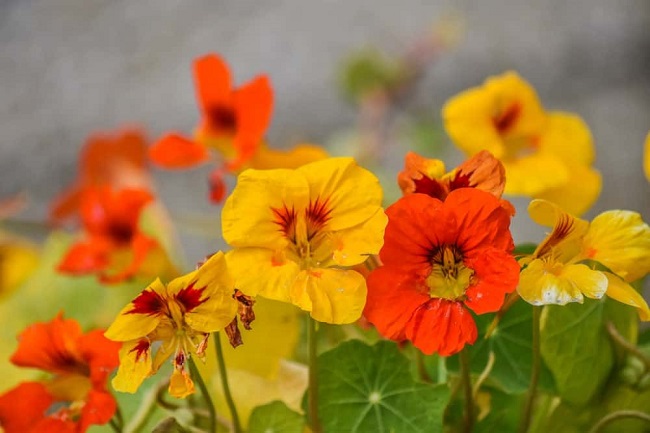Spring is traditionally symbolized by several motifs. Bunches of fresh flowers, wild or domesticated, symbolize the new growth and sweet possibilities of spring more than any other season. The loveliness of fresh petals and bright colors does not need to stop at the garden or greenhouse, however. A seasonal feast could include edible blossoms, perfect for a birthday party or other spring celebration.

Make sure that any fertilizers or pest and weed control applied to the plants are food safe. And you must also be certain that the variety of flower to be eaten is safe to eat. For these reasons, growing one’s own edible flowers is one way to have a reliable source of these pretty ingredients.
Many of the plants that we already grow for food have edible flowers. Often, the flower is similarly flavored to the plant itself- it’s just that the flavor can be either more intense or more subtle. The flowers of many herbs replicate the leaves in flavor. Some of these blooms are quite savory indeed, including arugula, basil, and chive flowers. These three plants’ flowers are lovely tucked into a lightly dressed salad and scattered on a dip or soup for garnish. Anise hyssop, borage, and bee balm, as well as mint flowers, are all slightly lighter and sweeter flavors; these are nice chopped on lemon sorbet or dried and used in teas. Radish flowers are milder and sweeter than the root and are a pretty garnish.
Some plants used for their looks are also surprising sources of edible blooms. Once again, it’s important to remember that it is unsafe to eat flowers from unknown sources or of unknown varieties. Remove pistils and stamens from larger flowers before eating and remove the petals from the rest of the stem just prior to use. For the following flowers, only the petals are for eating. Multicolored nasturtiums make a colorful and slightly spicy garnish for salads, cheeses, and open-faced sandwiches. Several varieties of scented geraniums are edible, though by all accounts, the citronella variety may not be edible. Flavors vary from lemon to mint and are based on the flower smell. Geraniums can be sprinkled on cold desserts or frozen into ice cubes. Another classic culinary flower is the rose. Rose petals as well as rose hips are widely used in food. Rose hips can be dried and used to make a tart and delicious tea, while the petals should be removed of their bitter white bases. Due to our regard for the lovely rose, rose petals are a romantic and elegant addition to desserts and some drinks. Their essence is distilled in rosewater, which is used in several world cuisines.
Candied rose petals, mint leaves and geraniums all make sparkly garnishes. Paint fresh, dry petals with a small paintbrush dipped in beaten egg white thinned with a little bit of water. Then while the glaze is still damp, sprinkle the petals with superfine sugar. Let these dry on a wire rack at room temperature or dry them more quickly in the oven at a maximum of 200 degrees, with the door open. Store them in an airtight container until ready to use.
Floral ice cubes are a pretty addition to a punch or springtime cocktails. Boil water for two minutes an allow it to come to room temperature, as this is a way to ensure clear ice cubes. Place flower petals in each well of an ice mold and fill halfway with the cooled, boiled water. Allow these to freeze, and then fill the wells the rest of the way with the boiled water and store in the freezer. Fruit juices could be substituted for water, or for savory cubes (to cool soup, perhaps), use herb flowers and broth.
Several flower flavors marry well with cheeses. There are several methods for adorning cheese with edible flowers. One involves the use of a gelatin glaze, to create a shiny coat around the cheese with flowers added in. Heat two cups of a dry white wine with one packet of unflavored gelatin and nest the cooking pot in a cool water bath to thicken the mixture as you stir gently (to avoid air bubbles). Paint the glaze on a nice flat wedge of Brie, or other cheese and let cool until the glaze is slightly tacky. Arrange flowers on the glaze and cool it in the fridge. Add additional layers of glaze to desired effect; heat and cool the remainder of the glaze to keep it workable.
More simply, however, chop herbs and their flowers somewhat coarsely and roll soft cheeses (chevre, cream cheese) in the chopped herbs and flower mixture. Log shapes or bite sized cheese balls are both delicious and pretty and these can be heated gently in the oven, with a little olive oil poured over the top.
Amy Ambrosius is a writer and budding gardener living deep in the heart of Texas with her family.
Related Articles & Free Email Newsletter Sign Up
How to Grow Vegetables in a Greenhouse Year-Round
Three Sisters Planting: A Concept in Edible Gardening
Vanilla Planifolia Edible Orchids as a Cash Crop




Comment here